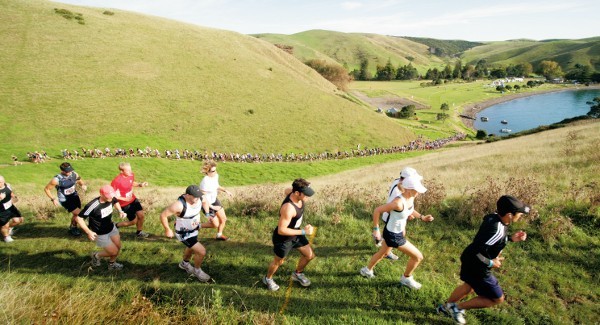The heroic Andy Kenworthy ponders a new – and ancient – quest for enlightenment
The heroic Andy Kenworthy ponders a new – and ancient – quest for enlightenment
“Please, don’t talk about what we’re doing,” I told my wife through gritted teeth. She was accompanying me on the last leg of a 21km run at the end of the Auckland Half Ironman, and was doing her best to be encouraging.
What she couldn’t have known is that I didn’t want to talk or think about running any more. In the previous six hours I’d swum 2km and cycled 90km. At this stage my toes were numb and I was taking such tiny steps one foot was scarcely landing in front of the other.
Staggering along like Night of the Lanky Zombies, my brain hammered the same question over and over again into my pounding skull: why am I doing this?
Well, I appear to be in good company, as our appetite for this kind of punishment is growing. Arron Carter, managing director of Total Sport, which organises many of these human demolition derbies, says it’s an epidemic. “We are definitely seeing a rise. We track entries for all our events and there has definitely been a build-up in the last couple of years. Those events that have limited numbers are selling out, some in about 10 minutes.”
And it’s not just a macho thing. Arron says it’s about fifty-fifty men and women, including an emerging group of mothers with children who often bring them along.
Pretty much every weekend throughout the warmer months, and less often in the colder ones, otherwisesane New Zealanders are choosing to put themselves through a form of hell on legs. It’s the same the world over: you can torment yourself in extremely long running races everywhere from the Sahara to the Antarctic.
Of course one obvious driver is the desire to get fit. Having had friends who were regular gym bunnies for years with no discernible effect, I am convinced that running is the quickest way to slim down and trim up. It is also the most accessible sport there is. All you need is a set of legs, and many a Paralympian has proved even they are optional.
But there seems to be something more to it. Author Christopher McDougall’s argument is neatly contained in the title of his 2010 bestselling book Born to Run, which has helped accelerate the craze. The theory is that running down animals in groups was the key to human evolution, imbuing running with a mystical quality. It suggests we can find the ancient and true within ourselves by running.
McDougall observed the traditional lifestyle of the Tarahumara Indians of the Copper Canyons of Mexico. Central to the Tarahumara culture is a game where they kick a ball for up to 65 miles at a time. According to McDougall, the Tarahumaras have almost no social problems. It’s possible they’re simply too tuckered to bother.
But it’s not just the Tarahumara Indians jogging their way to a higher plane. Here in New Zealand and elsewhere, the followers of Indian mystic Sri Chimnoy organise races on the basis that running is a means to self-transcendence.
And the sentiment is equally shared by an elite group of Buddhist monks in Mount Hiei, Japan. Those undertaking the seven-year Kaihigyo discipline get up at 1.30am to complete a marathon every day for 100 days in the first year, then in year four and five they run a marathon a day for 200 days on the trot. In the final year, they complete two marathons a day for 100 days.
This kind of thing obviously has the potential to put people into the kind of altered state favoured for mystical experiences of all kinds.
Meanwhile back at my race, I still have a long way to go before reaching enlightenment, or even a sandwich.
Andy Kenworthy is a regular contributor to Good and an irregular participant in endurance sports events. Read more at good.net.nz/andy






